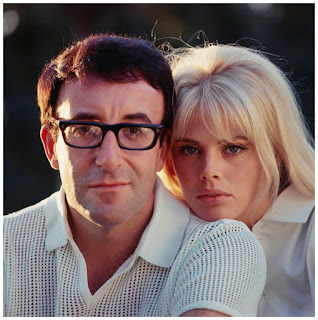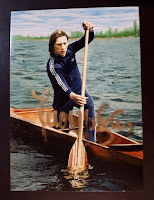 Simona Halep (n. ,[1] Constanța, România[1]) este o jucătoare profesionistă de tenis din România, aflată în prezent pe locul 1 mondial.[3] A câștigat turneul de Grand Slam de la Roland Garros (2018), după alte trei finale de Grand Slam: două la Roland Garros (2014, 2017) și una la Australian Open
(2018). Halep a câștigat de-a lungul carierei alte 18 turnee WTA la
simplu (șase în 2013, două în 2014, trei în 2015, trei în 2016, unul în
2017, trei în 2018), dintre care cele mai importante sunt turneele Premier Mandatory de la Indian Wells și Madrid. Următoarele premii ca importanță sunt cele de categorie Premier de la Montréal, New Haven, Connecticut, Moscova, Doha, Dubai, precum și cel de la turneul de la Sofia.
Simona Halep (n. ,[1] Constanța, România[1]) este o jucătoare profesionistă de tenis din România, aflată în prezent pe locul 1 mondial.[3] A câștigat turneul de Grand Slam de la Roland Garros (2018), după alte trei finale de Grand Slam: două la Roland Garros (2014, 2017) și una la Australian Open
(2018). Halep a câștigat de-a lungul carierei alte 18 turnee WTA la
simplu (șase în 2013, două în 2014, trei în 2015, trei în 2016, unul în
2017, trei în 2018), dintre care cele mai importante sunt turneele Premier Mandatory de la Indian Wells și Madrid. Următoarele premii ca importanță sunt cele de categorie Premier de la Montréal, New Haven, Connecticut, Moscova, Doha, Dubai, precum și cel de la turneul de la Sofia. 2008: titlu la Roland Garros (la junioare)
A început anul jucând finala la Notting Hill, dar a fost învinsă de Arantxa Rus, apoi a trecut de Anastasia Pavlyuchenkova în sferturile de finală ale turneului de junioare de la Australian Open, însă a cedat în semifinale în disputa cu Jessica Moore.La turneul ITF de la București, Halep a eliminat-o în primul tur pe fosta semifinalistă de la Roland Garros, Sesil Karatantcheva, înainte de a pierde în sferturi întâlnirea cu Sorana Cîrstea în trei seturi: 6–3, 3–6, 1–6.
În luna mai a câștigat două turnee de junioare: ITF de 10.000$ de la București, în fața lui Stéphanie Vongsouthi cu scorul 7-6(4), 6-3.[6] Victoria a fost urmată de succesul în turneul Trofeo Bonfiglio unde a învins-o pe Bojana Jovanovski cu 6–4, 6–1. [7]
 La turneul junioarelor de la Roland Garros,
Halep a fost desemnată cap de serie numărul nouă. În primul tur a
învins-o pe Charlotte Rodier, 6–4, 6–1, apoi pe daneza Karen Barbat,
6–3, 6–1. În turul trei, Halep a trecut de a cincea favorită, Jessica
Moore, 6–0, 6–1 pentru ca în sferturi să o învingă pe Ksenia Lykina, cap
de serie numărul 13, cu 6–1, 6–2. În semifinale, Halep a trecut de a
doua favorită, Arantxa Rus 6–3, 7–5, pentru a câștiga apoi o finală 100%
românească, scor 6–4, 6–7(3), 6–2 în fața celei de-a 10-a favorite, Elena Bogdan.[8][9]
La turneul junioarelor de la Roland Garros,
Halep a fost desemnată cap de serie numărul nouă. În primul tur a
învins-o pe Charlotte Rodier, 6–4, 6–1, apoi pe daneza Karen Barbat,
6–3, 6–1. În turul trei, Halep a trecut de a cincea favorită, Jessica
Moore, 6–0, 6–1 pentru ca în sferturi să o învingă pe Ksenia Lykina, cap
de serie numărul 13, cu 6–1, 6–2. În semifinale, Halep a trecut de a
doua favorită, Arantxa Rus 6–3, 7–5, pentru a câștiga apoi o finală 100%
românească, scor 6–4, 6–7(3), 6–2 în fața celei de-a 10-a favorite, Elena Bogdan.[8][9]
2009: titluri ITF și intervenția chirurgicală
În startul anului 2009, Simona Halep a ajuns în finala turneului ITF de la Makarska, fiind însă învinsă de principala favorită, Tatjana Malek cu 6–1, 4–6, 6-4. [10]În mai, a ajuns în sferturile de finală la turneul ITF de la București, unde a cedat în fața nemțoaicei Andrea Petkovic 6-2, 7-6(2). [11] În aceeași lună a evoluat în calificările turneului de senioare de la Roland Garros, unde a eliminat-o în primul tur pe Michaella Krajicek, cap de serie numărul 17, scor 6–4, 7–5, dar a cedat în runda următoare disputa cu Vitalia Diatchenko, 2-6, 6-1, 6-3. [12]
În august, Halep a câștigat turneul ITF de 25.000$ de la Maribor, în finală trecând de principala favorită, Katalin Marosi din Ungaria, cu 6-4, 6-2. [13]
La 18 ani, Simona a recurs la o intervenție chirurgicală de reducere a sânilor, care o incomodau în joc și îi creau și probleme cu coloana vertebrală.
 2017: Al treilea titlu Premier Mandatory, a doua finală de Mare Șlem - Roland Garros și realizarea punctajului pentru locul 1 WTA
2017: Al treilea titlu Premier Mandatory, a doua finală de Mare Șlem - Roland Garros și realizarea punctajului pentru locul 1 WTA
În următorul turneu, Australian Open, a jucat în turul I cu Shelby Rogers, fiind învinsă cu scorul 3-6, 1-6.
La începutul lui februarie, Simona a jucat la turneul Premier, St. Petersburg Ladies' Trophy, unde a început cu o victorie împotriva croatei Ana Konjuh (39 WTA), scor 6-4, 7-6 (2). Halep urma să joace, în sferturile de finală, împotriva rusoaicei Natalia Vikhlyantseva (19 ani, locul 115 WTA), sportivă venită din calificări, însă a fost nevoită să se retragă din cauza unei accidentări la genunchi.
La Indian Wells ajunge până în turul 2, unde este învinsă de Kristina Mladenovic cu scorul de 6-1, 6-3.
La Miami are un parcurs mai bun, dar a pierdut în trei seturi cu Johanna Konta în sferturi.
În Germania, la Stuttgart, merge până în semifinale, învinsă de Laura Siegemund cu 4-6, 5-7.
La Madrid, s-a impus pentru a doua oară, învingând-o în finală pe Kristina Mladenovic (17 WTA) cu scorul 7-5, 6-7 (7), 6-2. Astfel, devine prima jucătoare care ajunge de trei ori în finala turneului.
La Roma, ajunge în finală, fiind învinsă de Elina Svitolina, în 3 seturi 6-4, 5-7, 1-6. Meciul a fost marcat de accidentarea Simonei la glezna dreaptă.
La 10 iunie 2017, Simona a disputat a doua ei finală la Roland Garros, fiind învinsă în trei seturi (6-4, 4-6, 3-6) de Jeļena Ostapenko.
La 7 octombrie 2017, în urma victoriei din semifinala cu Jeļena Ostapenko de la Openul Chinei din Beijing, Simona a devenit noul lider mondial al Clasamentului WTA, fiind prima jucătoare de tenis din România clasată pe locul 1 WTA și devenind a 25-a jucătoare din toate timpurile care a deținut această poziție.[40]
La Turneul Campioanelor câștigă în primul meci cu Caroline Garcia, apoi pierde la Caroline Wozniacki și la Elina Svitolina, părăsind astfel competiția pentru al 3-lea an la rând încă din faza grupelor.
2018: Primul titlu de Grand Slam și accidentarea
 Simona începe perfect anul 2018, câștigând turneul de la Shenzen. În finală, ea a învins-o pe campioana din 2017 Katerina Siniakova în trei seturi: 6-1, 2-6, 6-0. De asemenea, s-a impus și la proba de dublu de la turneul chinez alături de Irina-Camelia Begu, învingând în ultimul act perechea Barbora Krejcikova/Katerina Siniakova, favorite principale. Pentru Simona e primul titlu WTA la dublu, iar pentru Irina al șaptelea.
Simona începe perfect anul 2018, câștigând turneul de la Shenzen. În finală, ea a învins-o pe campioana din 2017 Katerina Siniakova în trei seturi: 6-1, 2-6, 6-0. De asemenea, s-a impus și la proba de dublu de la turneul chinez alături de Irina-Camelia Begu, învingând în ultimul act perechea Barbora Krejcikova/Katerina Siniakova, favorite principale. Pentru Simona e primul titlu WTA la dublu, iar pentru Irina al șaptelea.
Halep pierde finala Australian Open, în fața danezei Caroline Wozniacki, într-un meci strâns, de trei seturi: 6–7(2–7), 6–3, 4–6.
În iunie 2018, Simona Halep reușește să câștige prima sa finală de Grand Slam la Roland Garros, învingând-o pe Sloane Stephens, numărul 10 mondial, cu 3-6, 6-4, 6-1, după ce pierduse primele doua finale la acest turneu cu Maria Șarapova (în 2014) și Jelena Ostapenko (în 2017).
În august 2018, Simona Halep a câștigat din nou turneul WTA de la Montreal, impunându-se pentru a doua oară consecutiv în fața americancei Sloane Stephens. Tot în august a ajuns în finala turneului de la Cincinnati, unde a pierdut în fața lui Kiki Bertens, deși a avut minge de meci în setul doi.
În septembrie 2018, Simona Halep a ajuns la 47 de săptămâni în fruntea ierarhiei mondiale și ocupă locul 11 într-un clasament all-time, apropiindu-se și mai mult de belarusa Victoria Azarenka, aflată pe 10, cu 51 de săptămâni pe prima poziție a clasamentului WTA[41].
În acea lună, a fost eliminată însă din primul tur la turneul de la Wuhan în ciuda unor dureri puternice,[42] și a abandonat în primul tur la Beijing.[43] O investigație cu RMN a relevat faptul că Halep suferă de hernie de disc.[44] Presa a speculat că nu ar fi trebuit să meargă la aceste turnee, dar a făcut-o pentru a obține bonusul de 1 milion de dolari din partea WTA pentru participarea la toate turneele Premier Mandatory și la patru din cele cinci turnee Premier Five.


























